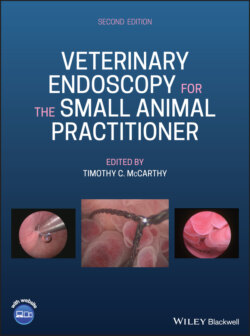Читать книгу Veterinary Endoscopy for the Small Animal Practitioner - Группа авторов - Страница 34
2.2.10 Flexible Endoscopes
ОглавлениеFlexible endoscopes are described by insertion tube diameter, working length, working channel diameter, tip deflection control, and video or fiberoptic image (Figure 2.34). For small animal practice, flexible endoscopes range in diameter from 2.8 to 9.7 mm, working lengths from 70 to 140 cm, two‐way and four‐way tip deflection control, 1–2.8 mm working channel diameter, and are available in fiberoptic and video options. Light transmission into the patient is through an incoherent fiberoptic bundle incorporated into the flexible endoscope insertion tube and flexible umbilical cord that connects to an external remote cold light source. Some flexible endoscopes use a flexible fiberoptic light guide cable as used with rigid telescopes to connect to the external light source. The advent of LED light sources has also made it possible to incorporate a light source into the endoscope (Figure 2.10).
Figure 2.34 The anatomy of a flexible fiberoptic gastrointestinal endoscope. A connector that attaches to a light source with an air pump for insufflation is at the proximal end of the umbilical cord. This connector has a light guidepost, an air insufflation tube, suction connector, lens washing water container connection, a pressure compensation valve, and electrical contacts. The umbilical cord runs from this connector to the handpiece of the endoscope carrying the light guide cable, suction channel, and air insufflation/water channel. The handpiece has an eyepiece section with fiberoptic endoscopes, angulation control knobs with breaking levers, a suction valve, an air insufflation/water valve, and an operating channel port. The eyepiece has a focus ring and camera attachment mechanism. Video endoscopes do not have the eyepiece section. The insertion tube is the portion of the endoscope extending from the handpiece to the distal tip that is passed into the patient. The tip portion of the endoscope is called the bending section and is the portion of the endoscope that is bent using the angulation control knobs on the handpiece. Additional information of flexible gastrointestinal endoscopes is presented in Chapter 3.
Addition of CCD and CMOS video chip technology to endoscopy has dramatically improved image quality beyond traditional fiberoptic images. Even though video endoscopes are more expensive, the increased image quality and elimination of deterioration in image quality of fiberoptic bundles over time make the added expense well worth the investment.
The most common flexible endoscopes used in small animal practice are the 2.8 mm diameter 70 cm, working length fiberoptic or video uretero‐cystoscope; the 6.2 mm diameter, 61 cm working length video bronchoscope; 5.2 mm diameter, 85 cm working length fiberoptic bronchoscope; and 7.9 or 9.7 mm diameter, 140 cm working length video gastroscopes (Table 2.4).
Table 2.4 Flexible endoscopes commonly used in small animal practice.
| Video gastroscopes9.7 mm sheath diameter, 140 cm working length, 4‐way tip control, 2.8 mm diameter working channel (Karl Storz #60914NKSK)7.9 mm sheath diameter, 140 cm working length, 4‐way tip control, 2.8 mm diameter working channel (Karl Storz #60714NKSK)Video bronchoscope (recommended to use feline video gastroscope)5.9 mm sheath diameter, 110 cm working length, 4‐way tip control, 2.0 mm diameter working channel (Karl Storz #60511NKSK)Fiberoptic bronchoscope5.2 mm sheath diameter, 85 cm working length, 2‐way tip control, 2.3 mm diameter working channel (Karl Storz #60001VLK2)3.7 mm sheath diameter, 65 cm working length, 2‐way tip control, 1.5 mm diameter working channel (Karl Storz #60002VBK2)Video uretero‐cystoscope8.5 Fr sheath diameter, working length 70 cm, 2‐way tip control, 3.6 Fr working channel (Karl Storz #60278VSK) |
